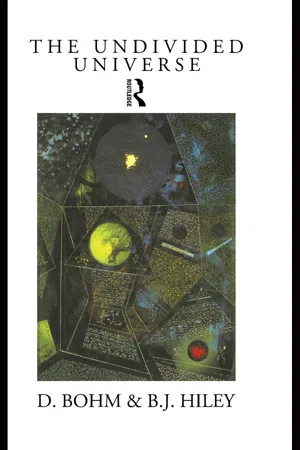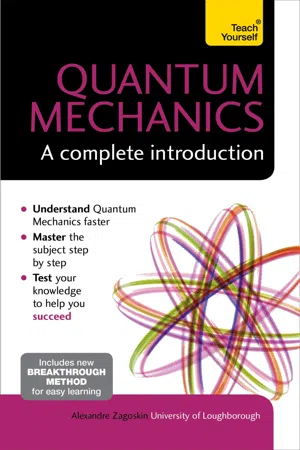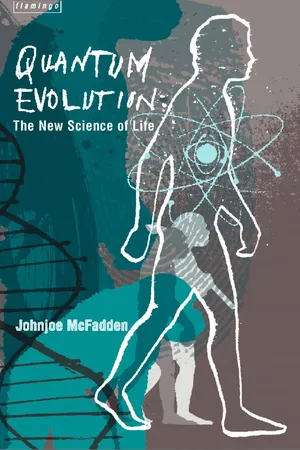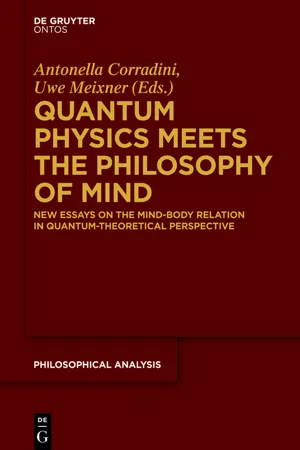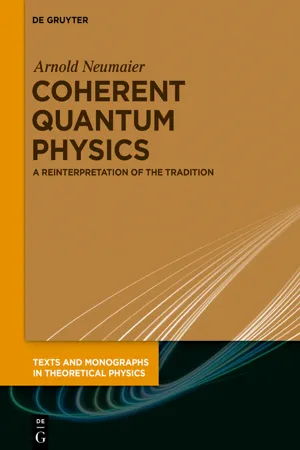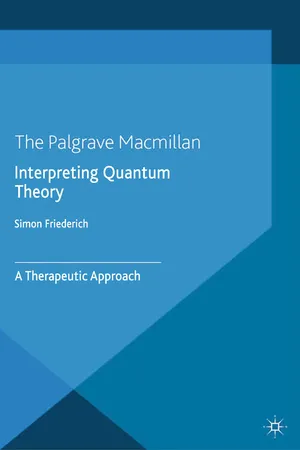Physics
Quantum Measurement
Quantum measurement refers to the process of determining the state of a quantum system. In quantum mechanics, measurement plays a crucial role in determining the properties of particles, such as position, momentum, and spin. The act of measurement in quantum mechanics is unique in that it can lead to the collapse of the wave function, resulting in a single definite outcome.
Written by Perlego with AI-assistance
Related key terms
Related key terms
1 of 4
Related key terms
1 of 3
12 Key excerpts on "Quantum Measurement"
- eBook - ePub
Interpreting Quantum Mechanics
A Realistic View in Schrodinger's Vein
- Lars-Göran Johansson(Author)
- 2016(Publication Date)
- Routledge(Publisher)
Chapter 6 The Measurement Problem6.1 Introduction
The measurement problem is the most central and persistent issue in the interpretation of quantum mechanics. It has been described in many ways, the most eloquent being that given by Wigner in the following way: quantum theory says that quantum systems evolve linearly, deterministically, continuously and reversibly according to the Schrodinger equation, except when we perform a measurement on the system. When measuring the value of an observable, whose wave function is not an eigenfunction to the operator representing the measured observable, the measurement is nonlinear, discontinuous, non-deterministic and irreversible. The superposition state changes, as a result of the measurement, into one of its components. In other words, the measurement induces a collapse of the wave function (Wigner, 1983). Why so? What is so special about measurements? After all, measurements are, disregarding our cognitive use of them, ordinary physical interactions and the Schrödinger equation offers a precise theoretical description of all physical interactions. But then, measurements ought to be continuous, deterministic and reversible, which they are not.Quite a number of proposals have been made to solve the measurement problem, all of which fall into one of three categories. Common to proposals in the first category is the view that the collapse of the wave function during the interaction is a mere change of our state of knowledge. The argument for this view is twofold: (i) the result of the measurement will finally become knowledge in the mind of the observer, and (ii) the measurement process has no physical properties differing from other interactions, hence the only relevant property of a measurement is its resulting in cognition. Assuming that the knowledge process in the mind of the observer cannot affect a physical process in the laboratory, it follows that the change of the state (the described state in quantum theory) is merely a change of knowledge about the real system. It follows that the wave function describes what is known about a system and not its physical state per se. - eBook - ePub
Quantum Implications
Essays in Honour of David Bohm
- Basil Hiley, F. David Peat, Basil Hiley, F. David Peat(Authors)
- 2012(Publication Date)
- Routledge(Publisher)
prima facie at least, absolutely central to the interpretation of the quantum-mechanical formalism.Now, the problem is not that quantum mechanics itself provides no criterion for when a measurement has taken place. That would not necessarily matter if we could find some criterion elsewhere (and, as we shall see, some alleged resolutions of the measurement paradox do in effect try to do just this). The problem is that quantum mechanics absolutely forbids a measurement to take place, if by a ‘measurement’ is meant a process which has the features ascribed to it in the standard textbook account. This statement needs some amplification. The point is that, if we believe (as most physicists at least implicitly seem to) that quantum mechanics is a universal theory, then it applies not only to single atoms and molecules but to arbitrarily large and complex collections of them, and in particular to the special collections which we have chosen to use as measuring devices (photographic plates, Geiger counters, etc.). So, although it is not obviously necessary to describe these objects, and their interaction with the microsystems whose properties are to be measured, in explicitly quantum-mechanical terms, it is at any rate legitimate to do so. Let us then initially (for the sake of simplicity of exposition only) assume that the measuring device starts in an initial state which is represented by a quantum mechanical wave function ψ0 . As before, we suppose that the property of the microscopic system which is to be measured is represented by a quantum-mechanical operator  with eigenfunctions φi and eigenvalues ai . Suppose, first, that a particular microsystem entering the apparatus is drawn from an ensemble whose quantum state is represented by the wave function φi Then, if we are to be able to read off the value of ai from the behavior of the macroscopic measuring device, the interaction between the microsystem and the device must induce the latter to make a transition into a different state, with a wave function we shall label ψi. (It is possible that one (but no more than one) of the ψiis identical to ψ0 in which case we speak of a ‘negative-result’ measurement. This feature in no way affects the general argument.) Moreover, the different states ψimust be not only mutually orthogonal but also distinguishable by purely macroscopic measurements (e.g. inspection with the naked eye). (A discussion (considerably more sophisticated than the above one, cf. below) of how some common measuring devices fulfil this condition is given in reference 5 .) At the end of the measurement process the ‘universe’ (system plus apparatus) is in a pure state χ which (for an ‘ideal’ measurement) is a product of φi and ψi - eBook - ePub
The Undivided Universe
An Ontological Interpretation of Quantum Theory
- David Bohm, Basil J. Hiley(Authors)
- 2006(Publication Date)
- Routledge(Publisher)
Chapter 6 Measurement as a special case of quantum process
As pointed out in chapter 2 , in the conventional interpretation of the quantum theory (which is basically epistemological in nature) measurement plays a key role in the sense that without it the mathematical equations would have no physical meaning. In our ontological interpretation, however, we have started with a treatment of the individual, actual process, e.g. a particle penetrating a barrier, undergoing transition between stationary states etc. Evidently it is necessary to deal with the measurement process in essentially the same way; i.e. as a special case of quantum processes in general. What is particularly significant in a measurement process is that from a large scale result that is observable in a piece of measuring apparatus, one can infer the state of the observed system, or at least the state in which it has been left after the measurement process is over.In this chapter we shall treat the measurement process in some detail and show how it is to be understood ontologically. We shall first discuss the general principles of this process. We shall show that the essential new feature of Quantum Measurement is that there is mutual and irreducible participation of the measuring instrument and the observed object in each other. As a result, any attempt to discuss this process as measuring ‘a property of the observed object alone’ will not be consistent with our interpretation. Rather we say that the result of a measurement is a potentiality of the combined system and can be determined only in terms of the properties of the particles, along with the wave function of the combined system as a whole. On the basis of this notion, we shall go into several examples that help illustrate the principles involved and clarify some of the puzzles to which these examples give rise in the conventional treatment. - Alexandre Zagoskin(Author)
- 2015(Publication Date)
- Teach Yourself(Publisher)
5 Observing the observablesIn Chapter 2 we discussed observation and measurement. We called the physical quantities, which characterize a quantum system, observables. We have stated that they are operators, i.e. subtler and more sophisticated mathematical entities than just numbers and vectors, with which we were satisfied in classical physics. We have introduced their eigenvalues and their expectation values in a given quantum state, that is, what we expect to observe respectively, in a single measurement or on average after many repeated measurements.Measurement, projection postulate and Born’s rule (revisited)All this sounded very natural. Science begins with observation and measurement. But in quantum mechanics these two words acquire a special importance and must be used with precision. Here they both mean the same, namely that measurement (or observation) is a special kind of interaction of a quantum system with another system called a measuring device, or apparatus. The apparatus is supposed to obey the laws of classical physics.The result of a measurement is that the state vector of the quantum system is projected on one of eigenvectors of one of the observables Â, which characterize the system. (Which observable it will be depends on the apparatus.) At the same time, the apparatus will evolve from its initial state to some final classical state, which is determined by which eigenvector the quantum state was projected to (Figure 5.1 ). This is called the measurement of the observable Â.Figure 5.1 Measurement, state vector projection and change in the classical apparatusOne should keep in mind that the observation and measurement in quantum mechanics do not- M.B Mensky(Author)
- 2017(Publication Date)
- CRC Press(Publisher)
One may think then that there is no need for a quantum theory of measurement. In a sense, there is indeed no need. Any particular system in any regime of measurement can be considered in the framework of conventional quantum mechanics without using the methods of the quantum theory of measurement. However, the quantum theory of measurement allows one to consider some situations in great generality and reach some general conclusions which hardly can be achieved by analysing particular situations. Moreover, some problems of a general character cannot even be formulated without the tools of the quantum theory of measurement. Consideration of the motion of photons in Heisenberg’s γ-microscope leads to the same conclusions as the uncertainty principle, but the latter is very important because of its generality as an effective instrument of physical analysis.The final conclusion from this analysis is that the problem of collapse can be avoided in practical calculations but inevitably emerges on the theoretical (conceptual) level. However, even in practical investigations the quantum theory of measurement with its picture of wavefunction collapse is useful (in fact necessary) firstly for simplifying computations and secondly for obtaining general results of the type of the uncertainty principle. Obtaining general conclusions of this type is one of the goals of modern Quantum Measurement theory (see for example Martens and de Muynck 1990).411.4.3 Quantum–Classical EvolutionIn one way or another, measurement leads to the emergence of classical elements in the description of a quantum system. In the path-integral approach this is seen in modification of the evolution law (see section 11.1 above and section 4.3 of Chapter 4 ). With the measurement taken into account evolution is described by the set of (alternative) operators Uαwhere α is the measurement output. The purely classical element α arises in this description as a sign of the influence of the measuring device. This may be treated in a wider manner as the influence of some sort of measuring medium (see section 4.4 of Chapter 4- eBook - ePub
- David Bohm(Author)
- 2012(Publication Date)
- Dover Publications(Publisher)
PART VIQUANTUM THEORY OF THE MEASUREMENT PROCESS
Passage contains an image
CHAPTER 22
1. Introduction. The quantum theory as developed thus far provides, in principle, a way to calculate the probable results of any measurement that one wishes to carry out. To calculate the average value of any observable A , we simply write , where ψ is the wave function of the system under investigation. If the quantum theory is to be able to provide a complete description of everything that can happen in the world, however, it should also be able to describe the process of observation itself in terms of the wave functions of the observing apparatus and those of the system under observation. Furthermore, in principle, it ought to be able to describe the human investigator as he looks at the observing apparatus and learns what the results of the experiment are, this time in terms of the wave functions of the various atoms that make up the investigator, as well as those of the observing apparatus and the system under observation. In other words, the quantum theory could not be regarded as a complete logical system unless it contained within it a prescription in principle for how all of these problems were to be dealt with.In this chapter, we shall show how one can treat these problems within the framework of the quantum theory.†2. The Nature of the Observing Apparatus. We shall begin by describing the general nature of an observing apparatus. In all cases, one obtains information by studying the interaction of the system of interest, which we denote hereafter by S , with the observing apparatus, which we denote by A - eBook - ePub
- Mark Julian Everitt, Kieran Niels Bjergstrom, Stephen Neil Alexander Duffus(Authors)
- 2023(Publication Date)
- Wiley(Publisher)
Often this is taken out of context, as much of quantum mechanics is understandable. Hopefully, our introduction to the different formulations of quantum mechanics and their connection to various forms of classical mechanics has helped make clear those parts of quantum theory that are as understandable as their classical counterparts. Feynman's statement does however carry weight for the current topic, as there have been many different attempts to interpret quantum mechanics, to resolve the measurement problem, and understand the theory's classical correspondence – none of which have been universally accepted. It would be safe to say that nobody fully understands Quantum Measurement and the quantum-to-classical transition. It is very much our intention not to be definitive in our treatment of this topic, but rather to use this chapter to generate thought and discussion. With this in mind, let us progress to the dialogue. 10.2 The Measurement Problem Question: So what is this measurement problem anyway? Reply: It is the problem that the rules of measurement in quantum mechanics appear to be fundamentally different from the rules of evolution. This is especially the case in the Schrödinger picture. Here, when a quantum system is evolving without being measured, the Schrödinger equation or some equivalent one in Heisenberg, phase space, or path integral formulation governs the system's dynamics - eBook - ePub
Quantum Evolution
Life in the Multiverse
- Johnjoe McFadden(Author)
- 2016(Publication Date)
- Flamingo(Publisher)
language by some kind of interpreter. Measuring devices are the interpreters which convert quantum events to classical phenomena: the position of a pointer on a dial, the click of a Geiger counter or indeed any detail of the world around us.The world is thus divided between an invisible quantum domain and the familiar realm that we perceive, obeying classical laws. Straddling that border are quantum-measuring devices. Physicists who examine the quantum realm utilize various measuring devices, ranging from the simple photographic plate to the twenty-seven kilometre long CERN Large Hadron Collider beneath Mont Blanc. Yet the nature of these tools, the measuring devices, remains the most enigmatic aspect of quantum mechanics. I will be arguing that, at its most fundamental level, the living cell is a quantum-measuring device which measures its own internal state. To understand life we must therefore examine how quantum-measuring devices make the world real.Quantum Measurement AND INFORMATION
Let us return once more to the famous two-slit experiment (as you can now see, Feynman was not exaggerating when he said that the experiment with two holes contains ‘all the basic peculiarities of quantum mechanics’). Our original aim was to accurately measure position and momentum for a photon – or electron or any other particle. We found that our ambition to achieve simultaneous measurement of both quantities was limited by the uncertainty principle. Our (less ambitious) revised aim was to demonstrate that the attributes of position and momentum were in fact real (though not simultaneously measurable) for a photon. This amounted to attempting to demonstrate that a single particle travels by a single route through only one of the slits to form scatter patterns. Yet single photons appeared to pass through both, generating an interference pattern. - eBook - ePub
- Antonella Corradini, Uwe Meixner, Antonella Corradini, Uwe Meixner(Authors)
- 2014(Publication Date)
- De Gruyter(Publisher)
The Quantum Measurement problem is arguably the most difficult conceptual problem in the foundations of physics. It is an indication of its difficulty that attempts to solve it have led physicists and philosophers of physics to speculate concerning the relationship between physical and mental states. We will consider the sense in which this relationship provides a degree of freedom that is tempting to use in addressing the measurement problem. We will start with Eugene Wigner’s understanding of the standard collapse formulation of quantum mechanics.Two years prior to being awarded the Nobel Prize in Physics, Wigner published a paper arguing that a consistent formulation of quantum mechanics requires one to endorse a strong variety of mind-body dualism. In particular, he argued:Until not many years ago, the ‘existence’ of a mind or soul would have been passionately denied by most physical scientists. […] There are [however] several reasons for the return, on the part of most physical scientists, to the Spirit of Descartes’ ‘Cogito ergo sum’ […] When the province of physical theory was extended to encompass microscopic phenomena, through the creation of quantum mechanics, the concept of consciousness came to the fore again: it was not possible to formulate the laws of quantum mechanics in a consistent way without reference to consciousness. - eBook - ePub
Coherent Quantum Physics
A Reinterpretation of the Tradition
- Arnold Neumaier(Author)
- 2019(Publication Date)
- De Gruyter(Publisher)
statistical instrument determines its final measurement results from a large number of raw measurements by averaging or by more advanced statistical procedures, often involving computer processing. Again, due to the law of large numbers, one obtains essentially deterministic results, but now from very noisy raw measurements. Examples include low-intensity photodetection, the estimation of probabilities for classical or quantum stochastic processes, astronomical instruments for measuring the properties of galaxies, or the measurement of population dynamics in biology.This behavior guarantees reproducibility. In other words, systems prepared in the same state behave in the same way under measurement—in a deterministic sense for a deterministic instrument, and in a statistical sense for a statistical one. In both cases, the final measurement results approximate, with limited accuracy, the value of a function F of the state of the system under consideration.11.5 Probability measurements
When it uses probabilities, […] science regards them […] as measurable (and calculable) physical quantities like lengths, energies, and wavelengths. […] The probability of a truly single event is intrinsically unmeasurable and […] science has nothing to say about [it.] To obtain the value of a physical quantity, one must measure it a number of times. Each measurement contains an error, and the ‘true’ value is (usually) computed as the arithmetic mean of all measured values. […] in a similar way [we] measure the relative frequency […] of an event in a series of trials. Each relative frequency contains an error, and the ‘true’ probability is computed as the mean of the relative frequencies over a number of series. […] nothing strange or inconsistent is left in the idea of probability as a measurable physical quantity.Henry Margenau, 1950 [179 , pp. 250–252]By its definition, the notions of q-expectations and q-probabilities belong to the formal core of quantum mechanics and are independent of any interpretation. But in the thermal interpretation all q-expectations, and in particular all q-probabilities, are among the objective properties. We discuss here basic aspects of their measurement.By the law of large numbers, q-expectations can be measured with (in principle) arbitrarily high accuracy by taking sample means of low-accuracy measurements, whenever there is a device (the preparation)—for example, a particle accelerator—that produces a large number of independent copies (realizations) of the same quantum system. The accuracy improves by a factor of N , where N - eBook - ePub
Interpreting Quantum Theory
A Therapeutic Approach
- S. Friederich(Author)
- 2014(Publication Date)
- Palgrave Macmillan(Publisher)
In particular, none of them are revealed in any way as the real states of the system and apparatus, and, correspondingly, none of the associated eigenvalues s i and a i are suggested as the actual values of observables at the outset of the measurement process. This result is, as it stands, incompatible with the manifest empirical fact that measurements actually do have determinate outcomes. It is evidently not of any help to allow that the measurement interaction may be less than ideal, for allowing that may to some degree deviate from c i or including contributions proportional to | a i 〉 ⊗ | s j 〉 with i ≠ j does not fundamentally change the situation. To conclude, unless one is prepared to deny either assumption 1.A – that the quantum state gives a complete description of the quantum system – or assumption 1.B that there exist no further dynamical principles of state-evolution besides the Schrödinger equation, one encounters a blatant conflict with an incontestable feature of our scientific and everyday lives: that measurements have determinate outcomes. Since the problem arises for arbitrary situations where the macroscopic properties of a physical system are assumed to be determinate and not only for ‘measurement’ situations in the narrow sense of the word, it is also (and appropriately so) referred to as the ‘ macro-objectification problem ’ (Ghirardi [2011]). 3.1.2 A fallacious solution Sometimes, a fallacious solution to the measurement problem is given, the core idea of which I will briefly discuss. It starts by considering the density matrix associated with the state (3.2), which (assuming an ideal measurement with for all i) is given by (where | s i a i 〉 is a shorthand for | s i 〉 ⊗ | a i 〉) and supposedly describes the combined system in the aftermath of ideal measurement. Next, one considers what seems to be the natural candidate if one wants to ascribe some quantum state to the measured system alone, i.e - eBook - ePub
- David Ferry(Author)
- 2019(Publication Date)
- Jenny Stanford Publishing(Publisher)
43 ].The point here is that modern physicists have managed to find ways to make measurements on a quantum system without collapsing the system, or its wave function. Certainly, some disturbance arises, but does not wipe out the system. Moreover, from these types of measurements, one has to ask whether the projection postulate put forward by Dirac and von Neumann is the full story of measurements in quantum systems, or is there more to be understood. But it is also quite clear that, for a system to undergo continuous measurements and remain a quantum system, there must be a degree of physical reality connected to the system, and this reality is quite likely to exist before the first measurements.Decoherence TheoryIn the previous chapter, the consistent histories approach to quantum mechanics was discussed. This approach is often called the GGHO approach after Griffiths, Gell-Mann, Hartle, and Omnès [44 ,45 ,46 ]. Let us review this method here. In the usual quantum mechanics, wave function collapse is considered the byproduct of measurements. In contrast, wave function collapse in the consistent histories approach is a mathematical procedure for calculating conditional probabilities during the quantum evolution [47 , 48 ]. Probabilities are introduced as part of the axiomatic foundations of quantum theory, irrespective of measurements. We can think of a history as a sequence of alternatives at a specific set of times [49 , 50 ]. These alternatives may be simple yes/no statements, but open the door for probabilities at each state. Thus, the states |ψ〉 at any point in time may each be characterized by a “probability” Pk for the possible states at that time. In the strictest interpretation, this probability is a projection operator which takes the entire Hilbert space to the allowed set of states. In this sense, the system is projected in the sense of Dirac [19 ], as mentioned above. The succession of the various states through which the system moves creates a trajectory in the spirit of Dirac [51 ] or Bohm [52 ]. In moving from one state to the next, it may be assumed that there is a time ordering in the states, with … tk < tk+1< tk
Index pages curate the most relevant extracts from our library of academic textbooks. They’ve been created using an in-house natural language model (NLM), each adding context and meaning to key research topics.
Explore more topic indexes
Explore more topic indexes
1 of 6
Explore more topic indexes
1 of 4


